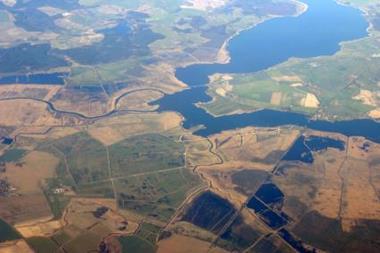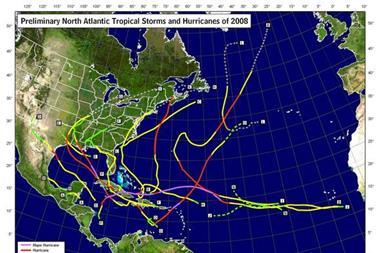The 2007 UK summer floods pushed flooding up the agenda for politicians and businesses alike. A year and a half later topographical maps and modelling technologies have improved to give us better tools to manage the risks. By Justin Butler
An unprecedented level of heavy rain in the wettest summer on record caused the 2007 UK floods. The Met Office says 414.1mm of rain fell across England and Wales in May, June and July – more than any time since it began compiling rainfall figures in 1766. In late June, this weather brought chaos to parts of northeast and central England and a month later, to parts of central and southern England and Wales.
Much of the damage occurred when the River Severn and its tributaries in the west of England burst their banks, but pluvial flooding (also called surface water flooding) was also a major cause, especially in the northeastern city of Hull where most, if not all, insurance claims were attributed to the accumulation of surface water.
Unlike other sources of flooding, pluvial has the potential to affect every urban centre in the United Kingdom. It happens when high intensity, long duration rains fall in areas with insufficient sewer capacity. The ageing UK sewer and drainage network was not built to withstand the heavy rainfall that has become more common.
Metropolitan developments have exacerbated the pluvial flood risk. There is a direct link between reduced permeability in the ground and increased flood risk. So when woodland is converted to industrial estates, or lawns turned to driveways, the risk of flooding increases significantly. A recent study conducted by Ambiental on behalf of Thames Water showed that the coverage of impermeable surfaces within selected London boroughs has increased, on average, by nearly 20% over the last 30 years.
The Government’s Foresight group, a high level think tank, estimated in its April 2004 report Future Flooding that around 4 million people and property valued at £200 billion in England and Wales alone were at risk of extreme flooding from fluvial and coastal sources. It also stated that about 80,000 properties are at very high risk from pluvial flooding (10%), causing on average £270 million of damage each year. Towns and cities, where there is a concentration of assets, have the prospect of heavier financial losses.
Government and industry reaction
After the 2007 floods, the Government commissioned Sir Michael Pitt, an engineer with wide public sector experience, to analyse the country’s flood defences. Published in June 2008, the extensive Pitt report identified 92 actions needed to protect the United Kingdom. The report called for a cohesive approach to flood prevention with greater involvement from local authorities and utility companies, and the creation of a Cabinet department. It also recommended an almost total ban on building on flood plains.
After much political wrangling, a long term plan with cooperation from industry and government has now emerged. The Association of British Insurers (ABI) agreed a 25 year flood plan with the Department for the Environment, Food and Rural Affairs (DEFRA) in July 2008. Both organisations have made a commitment to improve understanding of flood risk. The Government, meanwhile, promised to implement a strategy for flood prevention, future policy and funding.
Protecting key infrastructure
The 2007 floods highlighted the precarious position of key services. An internal Environment Agency report later concluded that nearly 5,000 sites of "critical infrastructure" were built on flood plains and most had little or no protection.
In response to the Pitt report, the water services regulation agency, OFWAT, has demanded flood risk assessment as part of budget reviews in April 2009. OFWAT has asked companies to evaluate the risk flooding poses to all sites and identify whether more investment is needed in defences.
It also commissioned consultants Halcrow to report on asset resilience to flood hazards and the development of an analytical framework. This outlines a process for dealing with flood risk which falls into three broad categories:
• Risk screening
• Risk assessment
• Risk management
The risk screening element is the process of identifying quickly which assets may be at risk. Environment Agency flood hazard mapping may be used for this preliminary test, but it is no longer recommended for the more detailed stage of risk assessment. At the same time companies need to judge the consequences if each asset were to fail. Would service be disrupted? How significantly, and to how many properties?
These two procedures are being used to conduct a cost-benefit analysis and define how much it is reasonable to spend on protecting individual assets.
Once low risk assets are set aside, the company must then move to a thorough risk assessment. OFWAT has drawn attention to the deficiencies in Environment Agency data and said that additional sources of flood risk information may be needed to achieve a quantitative analysis of risk. In particular, the authority has advised companies to source more accurate data on pluvial and groundwater flood hazards.
Technology
This need for more accurate models to simulate water flow and predict the impact of pluvial flooding spurred Ambiental to create new functionality within its existing Flowroute flood modelling software platform to enable detailed, and accurate pluvial flood risk mapping and modelling over wide areas. Underpinning this platform are complex equations and algorithms which simulate the ways in which water flows through a landscape. This allows the depth, extent, duration and velocity of floodwaters to be modelled, for multiple return periods, down to the level of individual buildings.
Flood depths, extents and velocities are crucial variables which need to be considered for all types of flood risk. However, in the pluvial case, patterns of flooding tend to be localised and depend very strongly on topographic characteristics, such as kerblines, drainage features and buildings.
Further, with pluvial flood risk modelling, every cell in the model is wet; rainfall-induced flooding operates over the entire model domain, as opposed to river flood modelling, where flooding will be restricted to a ‘corridor’ adjacent to the river itself. As every cell is wet at the start of a pluvial simulation, it required a significant enhancement in computational efficiency to cope with the huge number of calculations, using innovative methods for distributed/parallel computing.
For example, our pluvial model of London enables risk rating down to the level of individual buildings for the entire city within the M25. This equates to tens of millions of cells which need to be processed simultaneously as part of the simulation.
The model is new in that it provides additional functionality to the existing Flowroute flood modelling platform to enable efficient, building-level pluvial flood risk modelling and mapping including light detecting and ranging (LiDAR) digital topographic models, building data, hydrological data such as river flows and rainfall levels, building vulnerability data, such as depth damage curves and exposure data.
Output from the model is typically in the form of unit postcode risk rating databases, detailed building-level geographical information system (GIS) maps and bespoke reports and scenario models for primary underwriting or loss estimates for reinsurance purposes.
The data shows the level of risk for each building in an entire city, along with measures of severity for each return period. As such, the modelling is deterministic in nature, but can also be used within a probabilistic modelling framework to sanity check catastrophe models (by providing higher granularity data) or to improve the quality of cat model predictions by incorporating individual building heights into flood loss estimations.
This model has been independently compared with real claims in Hull after the 2007 floods and found to provide a very good match, the vast majority of the claims falling into the high risk category.
Flooding as an increased risk
Flooding is likely to remain one of the highest risks to infrastructure and urban centres in the United Kingdom. Incidents of monsoon-like, localised rain have occurred throughout 2008, and climate experts predict this is likely to continue.
Sea levels present a further danger, and the 2100 Thames Estuary project in London is looking at projected sea level rises of between 1m and a worst case scenario of 4.2m over the next 100 years.
However, in the face of these increased risks, human endeavour stands a good chance of protecting the United Kingdom, at least to some extent, from the impacts of extreme flooding. Technology and topographical data give us the tools – we now need to work together to fully understand the risks to individual sites and whole regions. Only then can rigorous risk management activities ensure that infrastructure and communities are appropriately defended.
Postscript
Justin Butler is managing director of Ambiental.
justin.butler@ambiental.co.uk
www.ambiental.co.uk



















